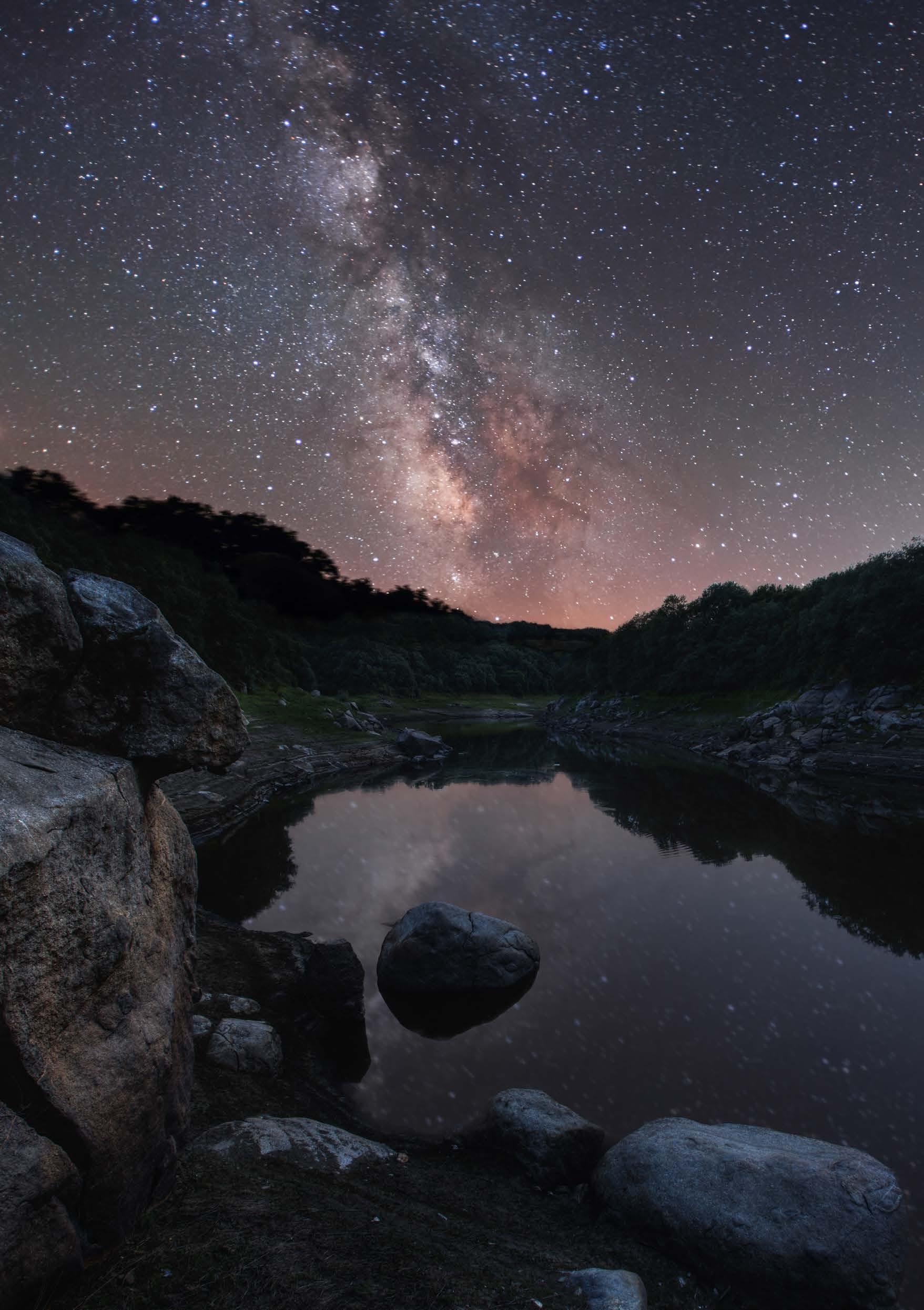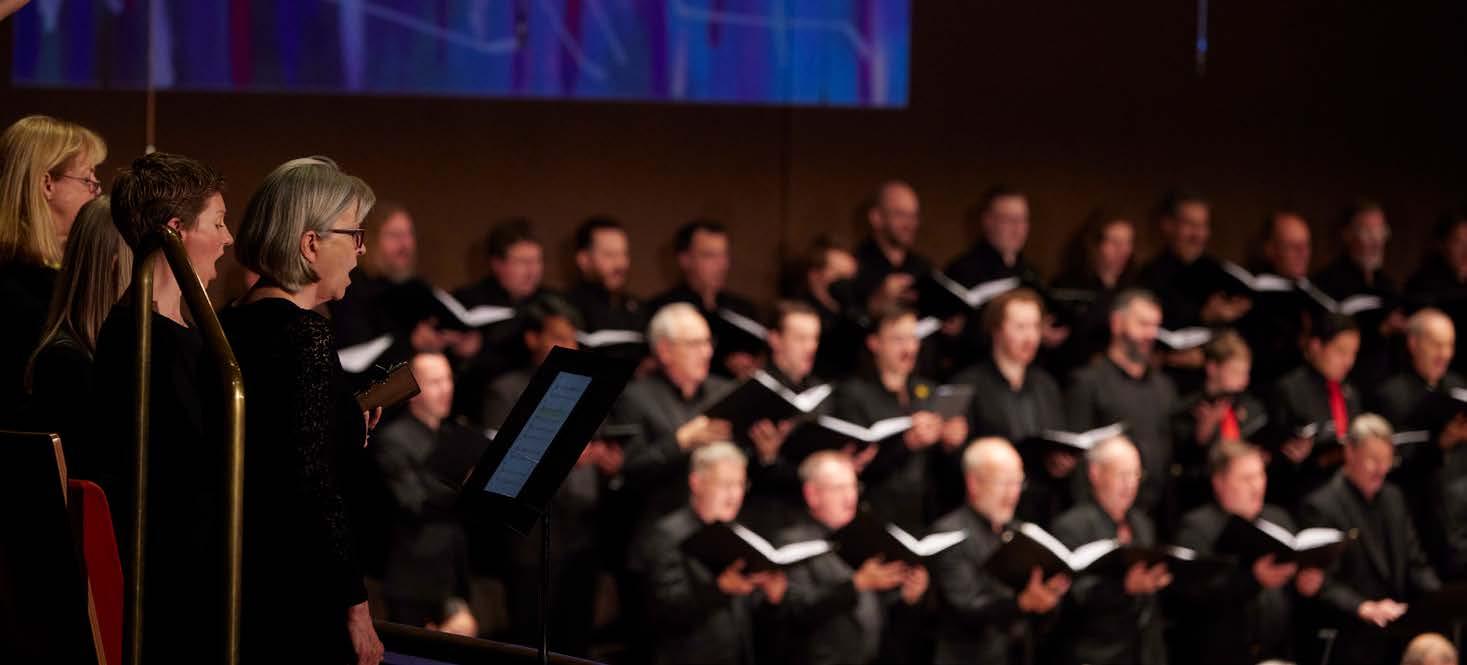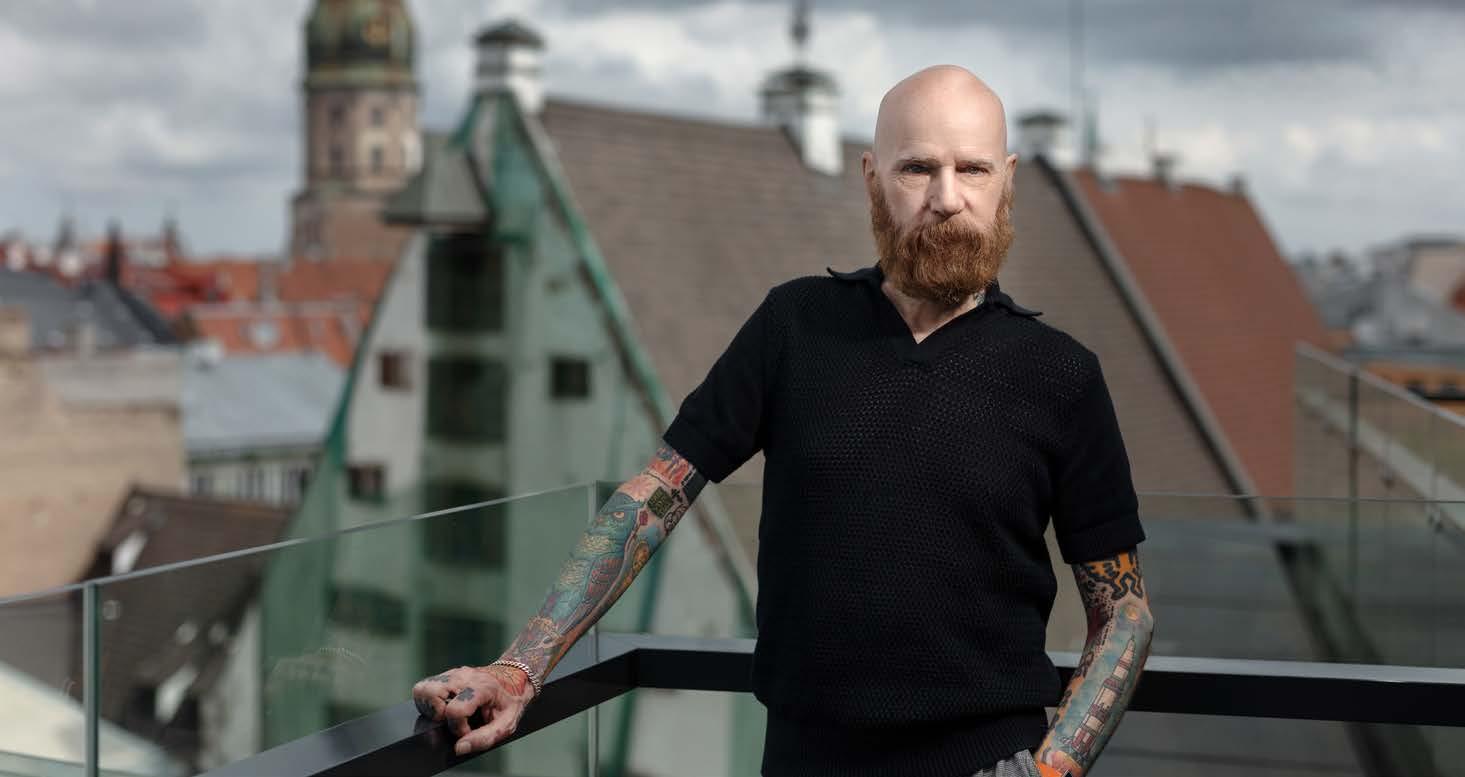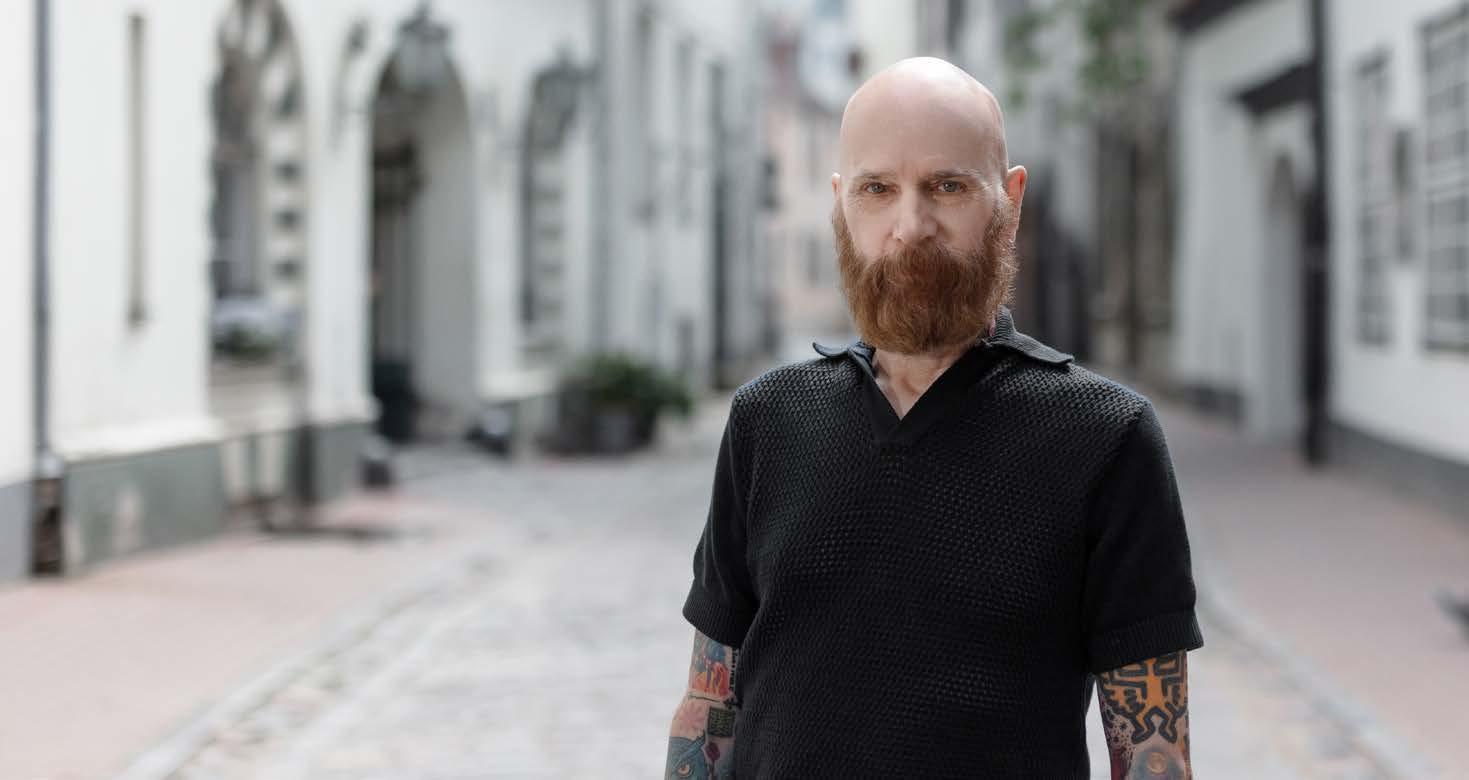11 October 2025
Iwaki Auditorium


11 October 2025
Iwaki Auditorium


Saturday 11 October at 7:30pm Iwaki Auditorium, ABC Southbank Centre
Artists
MSO Chorus
Warren Trevelyan-Jones conductor with
Ariel Volovelsky cello
John Arcaro percussion
Robert Cossom percussion
Timothy Mallis chamber organ Program
Victoria Missa pro victoria [19’]
Joe Twist Versa est in luctum – Motet [5’]
Victoria O quam gloriosum – Motet [3’]
Gabriel Jackson To the Field of Stars [38’]
Running time: 1 hour and 10 minutes without interval. Timings listed are approximate.

Celebrating 60 years of creating inspiring musical moments, the Melbourne Symphony Orchestra Chorus gives voice to the Orchestra’s choral repertoire. The MSO Chorus has performed with the finest conductors including Jaime Martín, Sir Andrew Davis, Edward Gardner, Mark Wigglesworth, Bernard Labadie, Vladimir Ashkenazy, Xian Zhang, Nodoko Okisawa and Simon Halsey.
Committed to developing and performing new Australian and international choral repertoire, the MSO Chorus has commissioned works such as Brett Dean’s Katz und Spatz, Ross Edwards’ Mountain Chant, and Paul Stanhope’s Exile Lamentations, and its recordings have received critical acclaim. The Chorus has performed across Brazil and at the Cultura Inglese Festival in São Paolo, with the Australian Ballet and the Singapore Symphony Orchestra, at the AFL Grand Final and at Anzac Day commemorative ceremonies.

Warren Trevelyan-Jones is regarded as one of the leading choral conductors and choir trainers in Australia. Chorus Director of the Melbourne Symphony Orchestra since 2017, last year he was also appointed Chorus Master of the Tasmanian Symphony Orchestra. From 2008 to 2024 he was Head of Music at St James’, King Street in Sydney, and under his leadership, the Choir of St James’ gained an international reputation through its regular choral services, orchestral masses, concert series, recordings, and interstate and international touring, as well as the commissioning of new works.
Before relocating to Australia in 2008, he enjoyed an extensive career as a vocal soloist and ensemble singer in
Europe, including nine years in the Choir of Westminster Abbey, and regular work with the Gabrieli Consort, Collegium Vocale (Ghent), the Kings Consort, Dunedin Consort, the Sixteen, the Tallis Scholars and the Taverner Choir, Consort and Players. He has appeared on more 60 recordings and numerous TV and radio broadcasts, and in many of the worlds’ leading music festivals and concert halls.
Warren is a co-founder of the Consort of Melbourne and, in 2001 with Dr Michael Noone, he founded the Gramophone Award-winning group Ensemble Plus Ultra. He is also an experienced singing teacher and qualified music therapist.
Sopranos
Philippa Allen
Sheila Baker
Tina Battaglia
Giselle Baulch
Michele de Courcy†
Ella Dann-Limon
Samantha Davies
Catherine Folley
Susan Fone
Karina Gough
Kim-Sue Hendry
Penny Huggett
Natasha Lambie†
Judy Longbottom
Susie Novella
Julie O’Reilly
Jodi Samartgis
Kathryn Scully
Julienne Seal
Jemima Sim
Fiona Steffensen
Tracey Thorpe
Ariane Vrisakis†
Altos
Ruth Anderson
Cecilia Bjorkegren
Kate Bramley
Jane Brodie
Jacqueline Cheng
Alexandra Chubaty
Andrea CliffordJones
Juliarna Clark
Mari Eleanor-Rapp
Nicola Eveleigh
Claudia Funder
Jill Giese
Kristine Hensel
Helen Hill
Natalie Lezhenko
Helen MacLean
Nicky Paterson
Natasha Pracejus
Alison Ralph
Kate Rice
Kerry Roulston
Lisa Savige
Victoria Sdralis
* narrator (To the Field of Stars)
† soprano soloists (To the Field of Stars)
Tenors
James Allen
Steve Burnett
Allan Chiang
James Dal-Ben
James Dipnall*
Lyndon Horsburgh
Michael Mobach
Colin Schultz
Robert Simpson
Stephen Wood
Basses
Kevin Barrell
Tharanga Basnayake
Roger Dargaville
Peter Deane
Elliott Gyger
Andrew Ham
Jordan Janssen
Gary Levy
Philip McCosker
Douglas Proctor
Stephen Pyk








As we celebrate our 60th anniversary and reflect on the impact that Melbourne Chorale, and subsequently the MSO Chorus, has had on the arts scene in Melbourne, , which was commissioned and first performed by the MSO Chorus in 2011. was written to commemorate the 400th anniversary of the death of Tomás Luis de Victoria, one of Spain’s greatest composers, and was inspired by the Camino de Santiago, or Way of St James, the great pilgrimage to Santiago de Compostela. It mixes religious texts with poems by Walt Whitman, Emily Dickinson and William Cowper, and a diary entry from former US President John Adams. Gabriel Jackson noted that his work is about ‘journeying in the wider sense – the physical, emotional and psychological struggle to reach a long-sought-after and by Australian composer Joe Twist was also written to commemorate the Victoria anniversary in 2011, and like many contemporary choral composers, both Jackson and Twist have taken music from the great masters of the Golden Age on a journey of transformation, weaving it with intricate rhythms and
is a Renaissance masterpiece – a majestic nine-voice setting of the Mass Ordinary that showcases the composer’s sublime craftsmanship and devotion. His celebratory motet O quam gloriosum was written for the Feast of All Saints and it also forms the ecstatic conclusion to Jackson’s To the Field of Stars. It is perhaps one of his best-known works, packed with energy and rhythmic drive.

Tomás Luis de Victoria (c. 1548–1611)
Missa pro victoria
Kyrie Gloria Credo Sanctus Benedictus
Agnus Dei
Timothy Mallis chamber organ
Tonight’s journey begins in Madrid, in the final decade of the 16th century, at the Royal Convent of Las Descalzas – the ‘barefoot nuns’ of St Clare. María, dowager Empress of Spain and sister of Philip II, has retired to the convent as a lay resident and her retinue includes the great composer of the Spanish Golden Age, Tomás Luis de Victoria.
Victoria’s own journey had taken him from Ávila, where he’d learned his craft as a boy chorister in the cathedral, to Rome as a gifted teenager. His talent had won him the patronage of Philip II and he enrolled as a singer at the Collegium Germanicum. This Jesuit seminary trained priests to ‘win back’ Germany in the Counter-Reformation; fee-paying international students such as Victoria subsidised the mission.
In Rome, Victoria had met Palestrina (c.1525–1594), perhaps studied with him, and eventually succeeded him as maestro di cappella at the Seminarium Romanum. And he was busy: by the age of 37 he’d
published eight volumes representing more than 160 works. In one of these, in 1583, he wrote a dedication to Philip II expressing his wish to return home to Spain and lead a quiet life as a priest.
By October 1586, Victoria was in Madrid; a year later his wish was granted when he entered María’s service as her personal chaplain. It was not a musical post, but Victoria contributed to the musical life of the household and the lavishly resourced convent, and the royal connection was prestigious. More important, the job afforded him the leisure to compose and to travel.
From this quiet existence, sometime before the death of Philip II in 1598, emerged the Missa pro victoria, a magnificent setting for a double choir of five and four voices. Contemporaries described Victoria as having a naturally sunny disposition, and this mass suggests a witty intellect. The ‘Mass for victory’ title was almost certainly a pun on his name as well as an allusion to Christ’s victory over death as celebrated at Mass, with the choir as soldiers for the faith.
In what was known as parody technique, the mass is based on a popular old chanson by Clément Janequin (c.1485–1558) known as La bataille. This is the only time Victoria adopted a secular model for a mass. If you’re familiar with the ‘ritualised weeping’ of Victoria’s famous Officium defunctorum (composed following María’s death in 1603) and
imagine him as an austere mystic, the lively energy of the Missa pro victoria might surprise.
Victoria takes delight in clever quotations from the chanson, picking up on its battle noise effects (a kind of Renaissance beatboxing) and inherent drama to write music that sounds ahead of its time. The style is vivacious as well as picturesque – the closest Victoria ever came to writing a madrigal. As the Agnus Dei prays for peace, for example, we hear the same repeated note patterns that Janequin had used for his onomatopoeical vocal ‘bombardments’, and in the Christe Victoria adds another martial allusion, quoting the ‘L’homme armé’ (Armed Man) tune in a gesture his listeners would surely have recognised. Another surprise, if you

Joe Twist’s setting of the lamentation Versa est in luctum was composed in 2011 as part of Victoria Triptych – three motets marking the 400th anniversary of the death of Victoria. As Twist explains, it’s an honour for a living composer to pay tribute to a composer with a remarkable legacy lasting more than four centuries. ‘Victoria’s works are full of outstanding musical elements from which to draw inspiration,’ he says, ‘rich with wonderful arching phrases and ingenious part writing.’
associate Victoria’s music with a pure a cappella sound, is the presence of Victoria’s organ part (implying the potential inclusion of other instruments as well), which contributes to the joyous splendour of the music.
The Missa pro victoria was published in 1600 with a dedication to Philip III. The new king was a young man with fashionable tastes, and by Victoria’s account the mass became a favourite of his. But it also enjoyed popularity well beyond the orbit of the composer’s ‘quiet life’ in the Descalzas of Madrid. It’s easy to imagine it being sung in the Cathedral of Santiago de Compostela, inspiring pilgrims at the end of their long journey.
Yvonne Frindle © 2025
As heard in Missa pro victoria, many 16th-century composers paid homage to existing works by way of ‘parody’. Twist’s own compositions, including his orchestral works and film and television scores, exhibit a similar fascination with musical allusion and pastiche, and his setting of Versa est in luctum could be heard as ‘Victoria with a Twist’.
This funerary text was famously set by Alonso Lobo on the death of Philip II in 1598, as well as by Victoria himself as a companion motet for his Officium defunctorum, a requiem for the dowager Empress María composed in 1603. In his own Versa est in luctum, Twist quotes from the Officium defunctorum and echoes Victoria’s part writing, but takes the parody technique further by gradually juxtaposing the borrowed ideas with more modern influences such as repetitive minimalist textures and a rich, plaintive harmonic language drawn from the music of Steve Reich, Jonathan Dove, Arvo Pärt and James MacMillan.
Adapted from a note and interview by Joe Twist © 2011


Tomás Luis de Victoria (c. 1548–1611)
The Missa pro victoria was the work of a middle-aged composer enjoying a leisurely retirement. O quam gloriosum, by contrast, appeared in Victoria’s first book of motets in 1572 – the creation of a man in his early 20s, bringing together the clarity of style he was absorbing from Palestrina in Rome and the colour and expressive intensity of his native Spain.
Victoria published no secular music, but this, his most popular motet, draws freely on the word-painting strategies found in madrigals. The three ascending ‘O’s at the beginning, for example, convey an ecstatic wonder at the ‘glorious kingdom’. Later, on the word ‘gaudent’ (rejoice), the lower voices exuberantly race upwards while the sopranos sustain radiant long notes above. Pictorial devices like this, even if borrowed from secular composers, were appropriate for a genre that is literally ‘word music’ (from the French mot).
The words come from the joyous liturgy for the feast of All Saints (1 November) with its images of the saints in heaven with Christ, and as in the Missa pro victoria, we hear the composer’s ‘naturally sunny disposition’, to quote João IV of Portugal’s assessment of Victoria. There is an energy and vividness to the music that’s perfectly suited to the celestial subject matter, and which in turn will find a home at the end of our musical journey in the finale of To the Field of Stars.
Yvonne Frindle © 2025
Gabriel Jackson (born 1962)
Intrada – Refrain
1. Prayer for travelling – Refrain
2. Pilgrims’ song with history lesson –Refrain
3. Walking with God – Refrain
4. Miracles – Refrain
5. Our journey had advanced –Refrain
6. Campus stellæ (Field of stars)
7. Compostela (O quam gloriosum)
Ariel Volovelsky cello
John Arcaro percussion
Robert Cossom percussion
The composer writes…
Since the very first journeys to Santiago de Compostela in Spain began over 1,000 years ago, the Way of St James has been articulated and celebrated in music.
The vast Codex Calixtinus, dating from the 12th century, is a compendium of advice and instructions for pilgrims, sermons, reports of miracles, prayers and polyphonic motets. Over the years many concert programs have been devised to relive the mediæval pilgrims’ journey in song, drawn from the codex and other sources, and new pieces have been composed which also reimagine the experience of travelling the Way of St James.
So the challenge with this piece was to try to say something new and worthwhile about the pilgrimage to Santiago de Compostela that hadn’t already been said. I didn’t want to write a literal account of the journey, a series of postcards from the pilgrimage route – today we are in Puente la Reina... tomorrow we reach Finisterre –for that has already been done and done very well. So while To the Field of Stars is about the pilgrimage to Santiago, it is also about journeying in a wider sense – the
physical, emotional and psychological struggle to reach a long-sought after and life-changing goal.
One of the first things that struck me was the poem that is truly sacred in the broadest sense. possible etymological origin of ‘Compostela’ a ‘campus stellae’ –the field of stars. This suggested a literal field of stars, and that notion became the sixth movement of the piece, a sustained, glistening carpet of murmured stars’ names underpinning a flickering high cello descant.
In order to articulate and give structure to the journey, the piece is divided into seven movements, seven ‘stations’ as it were, points of meditation and reflection which are separated by choral refrains and brief cello envoix. The texts of the refrains are drawn from a mediæval pilgrims’ hymn in the Codex Calixtinus and they also act as a Latin grammar primer, each verse addressing St James in one of the six grammatical cases (nominative, genitive, vocative, etc.). These bare and rusticsounding refrains are isorhythmic – the rhythm remains identical each time, only the pitches changing.
The piece begins with an ecstatic and ululatory Intrada, a brief choral fanfare which apostrophises St James and his illustrious martyrdom. The seven movements that follow are both stages in the physical journey and reflections on the transforming experience of any arduous voyage, often sparked by key words in the preceding refrain in a kind of free association.
Prayer for travelling is by turns optimistic and apprehensive, full of both fear and excitement about the journey ahead. A quiet chorale is repeatedly answered by melismatic exclamations from upper voices and cello replete with sighing appoggiaturas and declamatory glissandi.
In the second movement, Pilgrims’ song with history lesson, the female voices sing of the joys of travel in rather obsessively jubilant tones. At this stage of the journey there is much to look forward to, and the almost-nonsense verse of their effusions is anchored by a jaunty march from the cello. Later in the movement we hear an account of the history of the shrine from the second president of the United States, John Adams.
Walking with God is dominated, in contrast, by the male voices, a dark-hued riposte to the bright cheerfulness of the preceding movement. Cowper’s poem, so familiar as a comfortable Anglican hymn, is here reimagined as a raw and angry dark night of the soul. Beset by doubt and uncertainty, the pilgrims sing in ornate and anguished tones, thoughts of the dove of peace offering a brief moment of balm, and leading to a quiet and unsure conclusion.
St James was noted for his performance of miracles, and in the fourth movement Walt Whitman tells of his apprehension of the divine in the everyday in a poem that is truly sacred in the broadest sense. Linguistically rich and full of ritualistic repetition, Whitman’s vision is set to some of the lushest music in the piece, its polyphonic intertwinings both meditative and sensual.
In Emily Dickinson’s Our journey had advanced, the end destination is almost certainly death (as was her wont) but that ‘God at every gate’ may equally be found at the shrine of St James. The movement is simple and quiet, for the most part, its bare homophony briefly overlaid with filigree in the second verse.
In a kind of otherworldly interlude, the whispered Field of Stars that is the sixth movement (Campus stellæ) supports a solo soprano cantilena that also longs for those ‘heavenly citadels among the stars’. And then, at last, we reach our


destination – the Basilica of St James –and ‘O how glorious is the kingdom’ indeed!
2011, the year in which the piece was written, was the 400th anniversary of the death of the great Spanish composer Tomás Luis de Victoria and here his iconic four-part motet O quam gloriosum is elaborated by a further four polyphonic voices, its long concluding pedal-point launching the final peroration, an exuberant and jubilant hymn to St James. Bedecked by virtuosic cello roulades and chiming bell sounds, the piece ends, exhausted but uplifted, in a clanging pæan of fortissimo ecstasy.
Gabriel Jackson © 2015
To the Field of Stars was commissioned by the MSO Chorus, Netherlands Chamber Choir, and St Jacob’s Chamber Choir, Stockholm, to commemorate the 400th anniversary of the death of Tomás Luis de Victoria and the pilgrimages to Santiago de Compostela. The premiere was given by the MSO Chorus with cellist Sharon Grigoryan on 19 November 2011 in Bendigo, followed by performances in Geelong and at St Patrick’s Cathedral, East Melbourne.
Gabriel Jackson is one of Britain’s most celebrated composers. Particularly acclaimed for his choral works, he collaborates with leading groups such as the Tallis Scholars, The Sixteen, Ars Nova Copenhage, Netherlands Chamber Choir, and The Crossing (Philadelphia). His work as Associate Composer to the BBC Singers (2010–13) included the virtuoso four-movement Choral Symphony. He was born in Bermuda in 1962. After three years as a chorister at Canterbury Cathedral, he studied composition with Richard Blackford and then John Lambert at the Royal College of Music. In 2003 he won the liturgical category at the British Composer Awards with O Doctor optime, and two further prizes in the choral category in 2009 and 2012. His major instrumental works include a piano concerto (2009) and Doonies Hill Antiphon (2010) for Red Note Ensemble. Recent premieres include The Christmas Story (2023, Choir of Merton College, Oxford), The World Imagined for tenor, chorus and orchestra (2021 Three Choirs Festival), and Mass of St James for choir and orchestra, commissioned for the bicentenary of St James’ King Street, Sydney and premiered in 2022.






